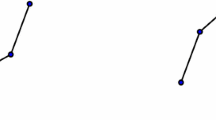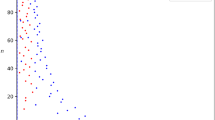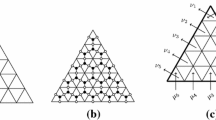Abstract
In this paper we rederive an old upper bound on the number of halving edges present in the halving graph of an arbitrary set of n points in two dimensions which are placed in general position. We provide a different analysis of an identity discovered by Andrejak et al., to rederive this upper bound of O(\({\varvec{n}}^{4/3}\)). In the original paper of Andrejak et al., the proof is based on a naive analysis, whereas in this paper, we obtain the same upper bound by tightening the analysis, thereby opening a new door to derive these upper bounds using the identity. Our analysis is based on a result of Cardano’s formula for finding the roots of a cubic equation. We believe that our technique has the potential to derive improved bounds for the number of halving edges.
Access this chapter
Tax calculation will be finalised at checkout
Purchases are for personal use only
Similar content being viewed by others
References
Andrzejak, A., Aronov, B., Har-Peled, S., Seidel, R., Welzl, E.: Results on k-sets and j-facets via continuous motion. In: ACM Symposium on Computational Geometry, pp. 192–199 (1998)
Bárány, I., Füredi, Z., Lovász, L.: On the number of halving planes. Combinatorica 2, 175–183 (1990)
Dey, T.K.: Improved bounds for planar k-sets and related problems. Discrete Comput. Geom. 19, 373–382 (1998)
Edelsbrunner, H., Valtr, P., Welzl, E.: Cutting dense point sets in half. Discrete and Computational Geometry 27, 243–255 (1997)
Erdős, P., Lovász, L., Simmons, A., Straus, E.G.: Dissection graphs of planar point sets. Surv. Comb. Theory, 139–149 (1973)
Kovács, I., Tóth, G.: Dense point sets with many halving lines. arxiv.org/abs/1704.00229v1 (2017)
Lovász, L.: On the number of halving lines. Ann. Univ. Sci. Budapest Eőtvős Sect. Math. 14, 107–108 (1971)
Matoušek, J.: Lectures on discrete geometry. Springer-Verlag, New York (2002)
Matoušek, J., Sharir, M., Smorodinsky, S., Wagner, U.: k-sets in four dimensions. Discrete Comput. Geom. 2(35), 177–191 (2006)
Nivasch, G.: An improved, simple construction of many halving edges. Contemp. Math. 453, 299–305 (2008)
Pach, J., Steiger, W., Szemerédi, E.: An upper bound on the number of planar k-sets. Discrete Comput. Geom. 7, 109–123 (1992)
Sharir, M.: An improved bound for k-sets in four dimensions. Comb. Probab. Comput. 20, 119–129 (2011)
Sharir, M., Smorodinsky, S., Tardos, G.: An improved bound for k-sets in three dimensions. Discrete Comput. Geom. 26, 195–204 (2001)
Tóth, G.: Point sets with many k-sets. Discrete Comput. Geom. 26, 187–194 (2001)
Author information
Authors and Affiliations
Editor information
Editors and Affiliations
Rights and permissions
Copyright information
© 2022 The Author(s), under exclusive license to Springer Nature Singapore Pte Ltd.
About this paper
Cite this paper
Solanki, N., Chauhan, P., Pal, M. (2022). Rederiving the Upper Bound for Halving Edges Using Cardano’s Formula. In: Sharma, T.K., Ahn, C.W., Verma, O.P., Panigrahi, B.K. (eds) Soft Computing: Theories and Applications. Advances in Intelligent Systems and Computing, vol 1380. Springer, Singapore. https://doi.org/10.1007/978-981-16-1740-9_21
Download citation
DOI: https://doi.org/10.1007/978-981-16-1740-9_21
Published:
Publisher Name: Springer, Singapore
Print ISBN: 978-981-16-1739-3
Online ISBN: 978-981-16-1740-9
eBook Packages: Intelligent Technologies and RoboticsIntelligent Technologies and Robotics (R0)




